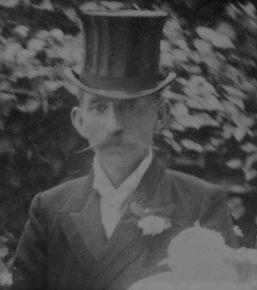Joseph Lawende facts for kids
Quick facts for kids
Joseph Lawende
|
|
|---|---|

Lawende, pictured in 1899
|
|
| Born | 9 February 1847 Warsaw, Congress Poland
|
| Died | 9 January 1925 (aged 77) |
| Nationality | Polish |
| Occupation | Cigarette salesman |
| Known for | Witness to a murder by Jack the Ripper |
| Spouse(s) |
Annie Lowenthal
(m. 1873) |
| Children | 12 |
| Parent(s) | Hirsch and Zirle Lawende |
Joseph Lawende (born February 9, 1847 – died January 9, 1925) was a cigarette salesman from Poland who later lived in Britain. He is well-known because he might have seen the person called Jack the Ripper. This sighting happened with Catherine Eddowes, who was the Ripper's fourth victim. Lawende saw them about nine minutes before her body was found on September 30, 1888.
Lawende gave a good description of the person to the police. Robert Anderson, a high-ranking police officer, later said Lawende was "the only person who ever had a good view of the murderer."
Contents
Joseph Lawende's Early Life
Joseph Lawende was born in Warsaw, Poland. At that time, Poland was part of the Russian Empire. His parents were Hirsch and Zirle Lawende, who were Jewish. Joseph moved to Britain in 1871.
On January 22, 1873, he married Annie Lowenthal in a synagogue in London. His brother Leopold had married Annie's sister the year before. Joseph and Annie had twelve children together. When he got married, he worked as a cigarette maker.
In 1881, records show he was still a cigarette maker. He lived with his family at 2 Tenter Street South. Around 1885, he moved to 45 Norfolk Road in Dalston. He also had a place in St Mary Axe where he made cigarettes.
The Mitre Square Sighting
In the early morning of September 30, 1888, two murders happened that were blamed on Jack the Ripper. Catherine Eddowes was the second victim that night. She was killed in Mitre Square.
Lawende and two friends, Joseph Hyam Levy and Henry Harris, were at the Imperial Club. They waited to leave because it was raining. After the rain stopped, they left just after 1:30 a.m. Lawende checked the time on his pocket watch. They started walking towards Aldgate.
About 15 yards from the club, they saw a man and a woman talking quietly. This was at the entrance to Church Passage, which led to Mitre Square. The woman had her hand on the man's chest, but it did not look like she was fighting him. Lawende later identified the woman as Eddowes by her clothes. He saw her clothing at the mortuary.
Lawende walked a little apart from his friends. He was the only one who really noticed the man. He quickly looked at him from about 9 feet away. He said the man was of average build. He looked a bit like a sailor. The man wore a loose jacket that was "pepper-and-salt" colored. He also had a grey cloth cap and a reddish neckerchief. Lawende thought the man was about 30 years old. He had a fair skin and a moustache. He was about 5 feet 7 inches to 5 feet 8 inches tall. Lawende did not think he could identify the man again. The Times newspaper later said Lawende described the man as about 5 feet 9 inches tall and looking a bit shabby.
The Metropolitan Police thought Lawende was a very important witness. They kept him away from the newspapers. At the investigation into Eddowes' murder, the City Solicitor Homewood Crawford said he had a special reason not to share details about the man's appearance. The coroner agreed. So, Lawende only described the man's clothes.
Major Henry Smith of the City of London Police was impressed by Lawende. Lawende was not interested in the earlier 'Ripper' murders. He would not be tricked by questions that tried to make him say more. Smith believed Lawende was a trustworthy witness.
Later Years of Joseph Lawende
Lawende became a British citizen in April 1889. By 1891, he and his family had moved to Islington. The census from 1891 shows that Lawende changed his name to Lavender. This spelling continued in the 1901 census. In September 1894, his daughter Ruby was born. At that time, his family lived at 116 Mildmay Road.
There are two known photos of Joseph Lawende, or Lavender. In 1899, he was photographed at his daughter Rose's wedding. Another photo was taken in 1923. This picture shows him sitting with his family. It was first shown in an online magazine called Ripperologist in 2008.
Joseph Lawende died in London in January 1925. He was almost 78 years old.
Police Views on Lawende
Some people who study the Jack the Ripper case believe Lawende was the witness mentioned by Robert Anderson. Anderson was a high-ranking officer from Scotland Yard. He said this witness was "the only person who ever had a good view of the murderer."
However, neither Anderson nor another officer named Swanson ever actually named the witness.
Joseph Lawende in Media
In the TV show Ripper Street (2013), an episode called 'What Use Our Work' featured Lawende/Lavender. He was played by the actor Linal Haft.
See also
- Cold case
- List of proposed Jack the Ripper suspects
- Unsolved murders in the United Kingdom
Images for kids


